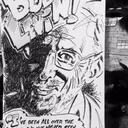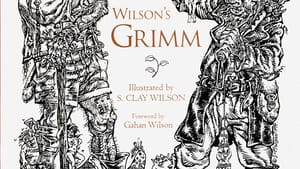Stay in the Loop
BSR publishes on a weekly schedule, with an email newsletter every Wednesday and Thursday morning. There’s no paywall, and subscribing is always free.
The perfect gift for the man who has everything, provided his possessions include an X-rated sense of humor, has arrived: S. Clay Wilson’s ABC, “an audacious, illustrated alphabet,” from Wordplay, edited and annotated by Malcolm Whyte.
S. Clay Wilson, along with Victor Moscoso and Rick Griffin, was one of the original cartoonists invited by Robert Crumb to join him in ZAP. ZAP, which is generally credited with transforming comics into a vehicle for adult artistic expression, and thereby liberating all of graphic art, was one of the most influential publications of the second half of the 20th century; and Wilson — whose uncensored, id-to-ink renderings of laugh-out-loud sex and violence blew what restraints remained upon his already freewheeling colleagues — was among its most influential artists.
Wilson’s comic book characters, from the Checkered Demon to Cap’n Pissgums, Ruby the Dyke to Star-eyed Stella, were unforgettable. And when he moved them into gallery quality paintings, they retained their wit and power. The comic art historian Patrick Rosenkranz has posited that no artist in history has “gone further... [than Wilson] in drawing mutilation and sexual deviancy.” His work has been compared to Breughel’s and has hung in museums beside Bosch. It was praised by Robert Hughes and Kenneth Clark. Kathy Acker, Charles Bukowski, William S. Burroughs, Chrissie Hynde, and Ken Kesey were fans.
Early in the morning of November 1, 2008, Wilson was found lying unconscious, in a cold rain, on a San Francisco street. Whether he had fallen or had been assaulted was never ascertained. But he had sustained frontal lobe damage, which left him hospitalized for a year and requiring 24-hour care since. He attempts to draw but discards all he creates.
No exposed genitalia, no sliced-and-diced body parts
ABC stems from Whyte’s Cottage Classics series of 20 years ago, which set select underground cartoonists spot-illustrating public-domain prose. Spain Rodriguez did Arthur Conan Doyle, Kim Deitch did Lewis Carroll, and Maxon Crumb did Edgar Allan Poe. Wilson handled both Hans Christian Andersen and the Brothers Grimm. He’d always wanted to illustrate children’s books, he told Whyte, “but after taking multiple acid trips in Lawrence, Kansas, I took a left turn graphically.” Agreeing to Whyte’s “no exposed genitalia/no sliced-and-diced body parts” mandate, designed to protect the kiddies in his reading public, Wilson returned to his original path smashingly.
Both volumes appeared in variously priced, limited editions, all of which sold out. At the expensive end were 26 signed and lettered volumes, each accompanied by an original illustration by Wilson. These illustrated letters, save for a few Andersens, which “got away” before they were copied, have been collected for the first time in this volume, accompanied by Whyte’s illuminating text.
Yuletide reimagining
Since the buyers of the pricier numbers were unlikely to be minors, Whyte unshackled Wilson for these illustrations, and the results are delightful. The Andersen release was timed for the Christmas market, and his trimmings are seasonal in spirit, if edgy in content. Fourteen of the 17 surviving drawings are Checkered Demon head-shots: cigarette-smoking, wine-sodden, leering, unshaven, pissed-off, lip-puckered under mistletoe, all red or green or red-and-green or candy cane-striped. Pushing boundaries further, two Demons are entertained by naked breasts; the “Y” has been gussied up to resemble a vagina; and one of the non-Demons is a severed angel head, lying, John the Baptist-like, in a pool of blood, upon a platter. The greetings Wilson penned beside his drawings — “Deck the howls with bowels of folly”; “Who the fuck is the baby Jesus?”; “Merry X-mess”; and “Jingle my balls” — completed his yuletide reimagining.
The Grimm book allotted Wilson a full page per letter, and here, in black-and-white, he gleefully ran further amok. There are, of course, breasts, vaginas, and (enormous) penises. There is anal and oral sex. There are severed dwarf heads, a humongous steaming stool pile, a gigantic ogre (munching upon a naked woman), witches (one naked, one munching upon a phallus), and a naked, rotting zombie, masturbating, though putting his member at risk. The principle that had guided Wilson through ZAP was that “You can do anything in a comic book.” You can, he now reminds us, do anything on a Christmas card, too. Or with a fairy tale. Or, if you have the courage and freedom of vision, practically anywhere. And the more taboos you break, the more freedom you gain to do the more consequential elsewhere.
ABC reminds us how bright and funny, how adept and imaginative Wilson was. It is a welcome addition to his oeuvre for his admirers and a nifty introduction for those to whom he is unknown.
What, When, Where
S. Clay Wilson's ABC by Malcolm Whyte, illustrated by S. Clay Wilson. Wordplay Books, 2014. $29.95 paperback; $75.00 deluxe signed, numbered, limited edition, with a portion of the sales income for the limited edition benefitting the S. Clay Wilson Trust. http://www.word-play.com/books/abc.html
For those who feel giving, www.sclaywilsontrust.com provides Wilson with necessities of life Social Security does not cover.
Sign up for our newsletter
All of the week's new articles, all in one place. Sign up for the free weekly BSR newsletters, and don't miss a conversation.
 Bob Levin
Bob Levin
